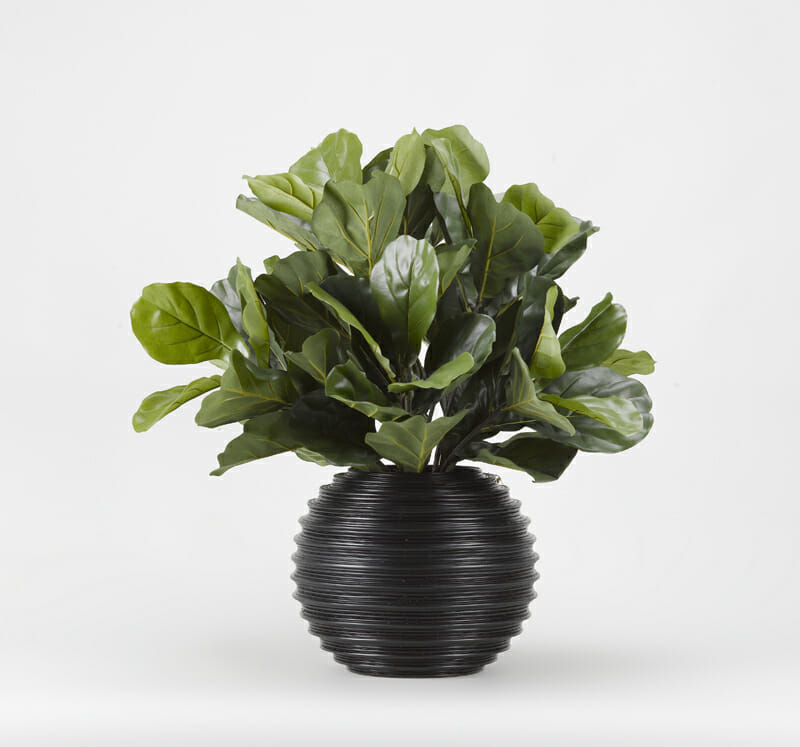 It seems that each decade’s decorating trends have been highlighted by a ‘houseplant du jour.’ In the 70’s, for instance, spider plants and ferns (often displayed in crocheted hanging baskets) were all the rage. The 80’s saw peace lilies rise in popularity; and in the 90’s, no house was complete unless there was a potted weeping fig stuck in a corner (no doubt, surrounded by a pile of fallen leaves on the floor!). The “It” plant for stagers today is, without a doubt (the New York Times said so!), the Ficas lyrata. Or, in layman’s terms, the fiddle-leaf fig.
It seems that each decade’s decorating trends have been highlighted by a ‘houseplant du jour.’ In the 70’s, for instance, spider plants and ferns (often displayed in crocheted hanging baskets) were all the rage. The 80’s saw peace lilies rise in popularity; and in the 90’s, no house was complete unless there was a potted weeping fig stuck in a corner (no doubt, surrounded by a pile of fallen leaves on the floor!). The “It” plant for stagers today is, without a doubt (the New York Times said so!), the Ficas lyrata. Or, in layman’s terms, the fiddle-leaf fig.
According to Daniel Kanter, a writer for Manhattan Nest, “The fiddle-leaf fig is interior design gold due to its striking, sculptural constitution; the thin trunk and big, lush leaves create an impeccable balance of negative space and immediately catch the eye. It’s the perfect solve for a barren corner or an awkwardly shaped area.” According to Wikipedia, the plant gets its name from the fact that the leaves, which are variable in shape—often with a broad apex and narrow middle—resemble a lyre or fiddle.
 According to Steven Kurutz in his New York Times article, “Designers love them because they have scale, work with a range of styles from modern to granny chic and seem to magically transform any room.” One reason for the rise in popularity of the fiddle-leaf fig according to Mr. Kanter: “They look really good in a picture.” Indeed, staging a room with a fiddle-leaf fig is one sure way to prepare it to be Instagram- (and
According to Steven Kurutz in his New York Times article, “Designers love them because they have scale, work with a range of styles from modern to granny chic and seem to magically transform any room.” One reason for the rise in popularity of the fiddle-leaf fig according to Mr. Kanter: “They look really good in a picture.” Indeed, staging a room with a fiddle-leaf fig is one sure way to prepare it to be Instagram- (and
listing)-worthy.
The problem is: fiddle-leaf figs—which are native to western Africa, where they grow in lowland tropical rainforests—are notoriously uneasy to keep alive in a household setting. The plants prefer the dense, dark, warm and wet attributes of the rainforest, which most homes do not provide. The answer, of course, is to invest in high-quality, faux alternatives that do not depend on water, light, food or climate.
 Look for faux substitutes that mimic real fiddle-leaf specimens with limbs and trunks made from lifelike or even natural elements; leaves that are imperfect, as in nature; and realistic soil or rocks. Workmanship and attention to detail matters in these plants, which at five- to eight-feet tall will command attention. You may pay more for ones that are hand-assembled, but they will look more lifelike than cheaper versions and last years longer with simple care, like proper storage, careful transit and the occasional dusting.
Look for faux substitutes that mimic real fiddle-leaf specimens with limbs and trunks made from lifelike or even natural elements; leaves that are imperfect, as in nature; and realistic soil or rocks. Workmanship and attention to detail matters in these plants, which at five- to eight-feet tall will command attention. You may pay more for ones that are hand-assembled, but they will look more lifelike than cheaper versions and last years longer with simple care, like proper storage, careful transit and the occasional dusting.
Below is a selection of faux fiddle-leaf fig trees to use in your staging efforts to:
- Fill empty spaces, such as a corner, foyer or balcony landing
- Draw the eye to a design element (i.e., upward to emphasize crown molding or
other elements of interest) - Soften hard edges
- Add a pop of green color
- Flank either side of a large window or piece of furniture
- Create a tropical oasis in a sunroom (check out the fiddle leaf fig screen below!)

Shop for DW Silks Fiddle Leaf Figs here.
- Stage With Subtle Hints of Gold For The Holidays - December 16, 2018
- Take a Stand: Create Visual Impact with Inspirational Planters - November 8, 2018
- The “It” Plant for Today’s Stager: Fiddle Leaf Fig - September 24, 2018








